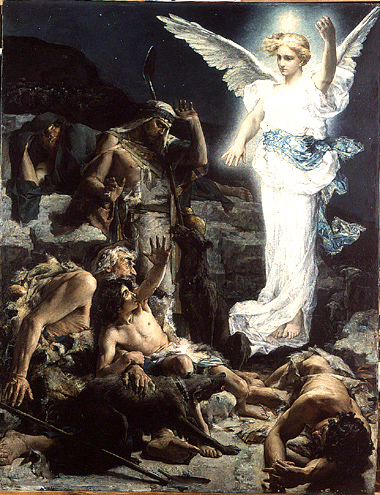
“And there were in the same country shepherds abiding in the fields keeping watch over their flocks by night. And, lo, the angel of the Lord came upon them, and the glory of the Lord shone round about them: and they were sore afraid. And the angel said unto them, Fear not; for behold I bring you tidings of great joy, which shall be to all people. For unto you is born this day in the city of David a Saviour which is Christ the Lord. And this shall be a sign unto you: Ye shall find the babe wrapping in swaddling clothes and lying in a manger. And suddenly there was with the angel a multitude of the heavenly host praising God, and saying, Glory to God in the highest, and on earth peace, good will toward men.” (Luke 8-14.)
The confrontation between the angelic host and the shepherds of Bethlehem has not been as popular a topic in Christian art as the Adoration of the Shepherds. In the fifteenth-century breviary of Martin of Tours we see a shepherd marching toward the Nativity as a bold bagpiper but in the image above, Leon François Comerre’s 1875 L’Annonce aux bergers, the emphasis is on the stark dread of the shepherds as they are dazzled by the sudden appearance of the luminous angel.
The annunciation to the shepherds is retold in carols such as “Shepherd, Shake Off Your Drowsy Sleep”, “While Shepherds Watched Their Flocks by Night”, and “Campana Sobre Campana”, and in medieval drama where it is the occasion for a good deal of mirth and low humour — a tradition which continues to the present day in Los Pastores. The above passage from Luke is recited by Linus in A Charlie Brown Christmas.